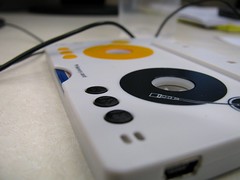Getting music from a CD to the preferred media player is a must for music lovers. After all, obtaining a home audio experience on the go is possible with digital music files – and the future is looking bright with the emergence of lossless digital audio. The sky is the limit for this more “pure” area of digital audio. Audiophiles should continue the hunt for the perfect format, at any “rate.”

A Look at Digital Music Formats
Once the MP3 made its initial release in 1993, it established the constant in the field of digital music formats. Able to take the Pulse Code Modulation (PCM) format –which is how a CD holds music – to a space-saving file, MP3 files were a quick hit. MP3s use lossy compression that compresses data; as a result, a 128 kbps MP3 file is approximately 1/11 the size of the original file.
Of course, MP3s are not the only option. There are several other digital music formats that are seen prominently, as well. Most digital music formats involve lossy compression, though that is not always the case:
- .mp3: The current standard that has stood the test of time. It uses lossy data compression to achieve an ideal balance of audio quality and space.
- .wav: This uncompressed audio format preceded MP3 files and is compatible with Windows, Macintosh, and Linux OS. Due to large file sizes, the WAV file has diminished in popularity
- .aac: Popular thanks to Apple, AAC is noted as being more advanced and efficient than MP3. Compatibility is a weak point for the file type, despite its success with the iPod.
- Others: WMA, OGG, ATRAC, and others span the wide market of alternative digital music formats.
Lossless-Format Music Files
As opposed to lossy formats, lossless formats boast certain advantages that appeal to audiophiles and practical music-lovers alike. By retaining all information in the original file, nothing is lost (hence the name). It boasts superior audio fidelity, despite larger file sizes.
Some of the more popular lossless music formats include the following:
- .flac: The open format FLAC is a popular codec that can losslessly compress music files to 50 to 60 percent of the original size. Like many current lossless formats, playback support in portable devices is limited.
- Dolyby TrueHD: A multi-channel audio codec from Dolby, which is a competitor with Dolby TrueHD in regard to DVDs. It boasts the ability to carry up to 14 discrete sound channels.
- HD-AAC: Uses Advanced Audio Coding (AAC) and Scalable Lossless Coding (SLS) to create lossless files.
- Others: APE, WV, m4a, and SHN are some of the many other lossless music file formats.
Future Developments
The battle for superb sound quality continues. Recently Neil Young has expressed the desire to improve upon lacking audio quality on MP3s. With his Pono system, high-end portable music players will use a download service that “will sell albums at far greater sound quality than iTunes,” according to Eamonn Forde.
Young isn’t alone in cultivating the state of future lossless digital audio formats and offerings. His competition, Apple, has been rumored to be looking into offering lossless music files for purchase through iTunes. And then there have been the flops, like Super-Audio CD and DVD Audio, as well as Pressplay and MusicNet services, Forde mentions.
The future of lossless audio will certainly depend on practicality. Will buyers need to purchase music yet again? How will storage concerns play out for mobile and home audio lovers? Until these items are met, lossless media formats will continue to be a niche market. From WAV and MP3 files to lossless codecs and services like Pono, the digital music world has seen a great deal – and it’s certainly not over.









